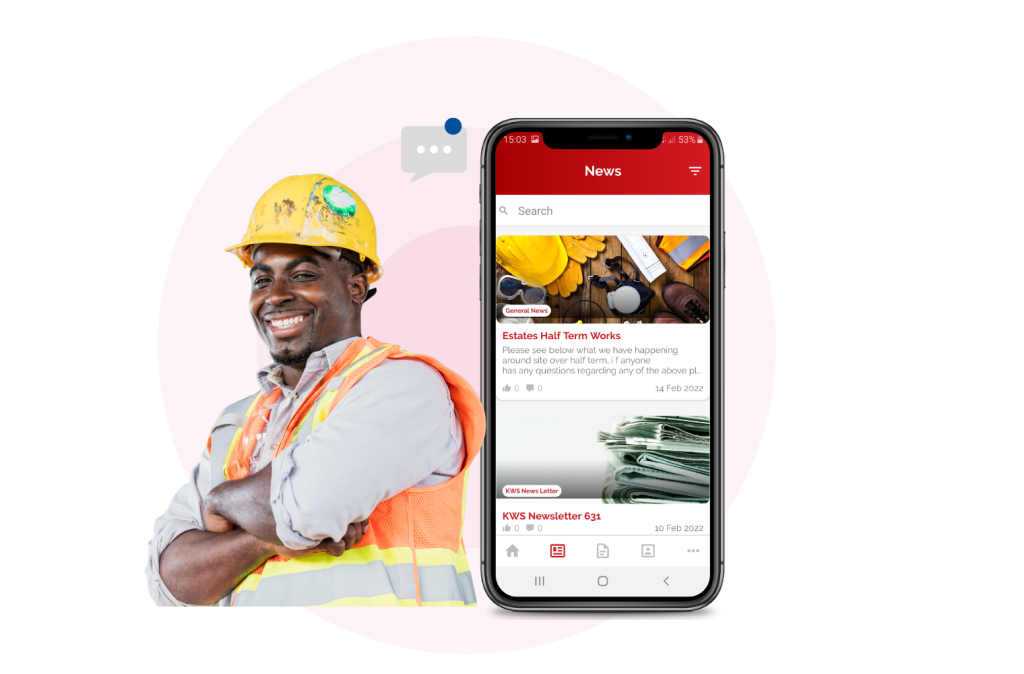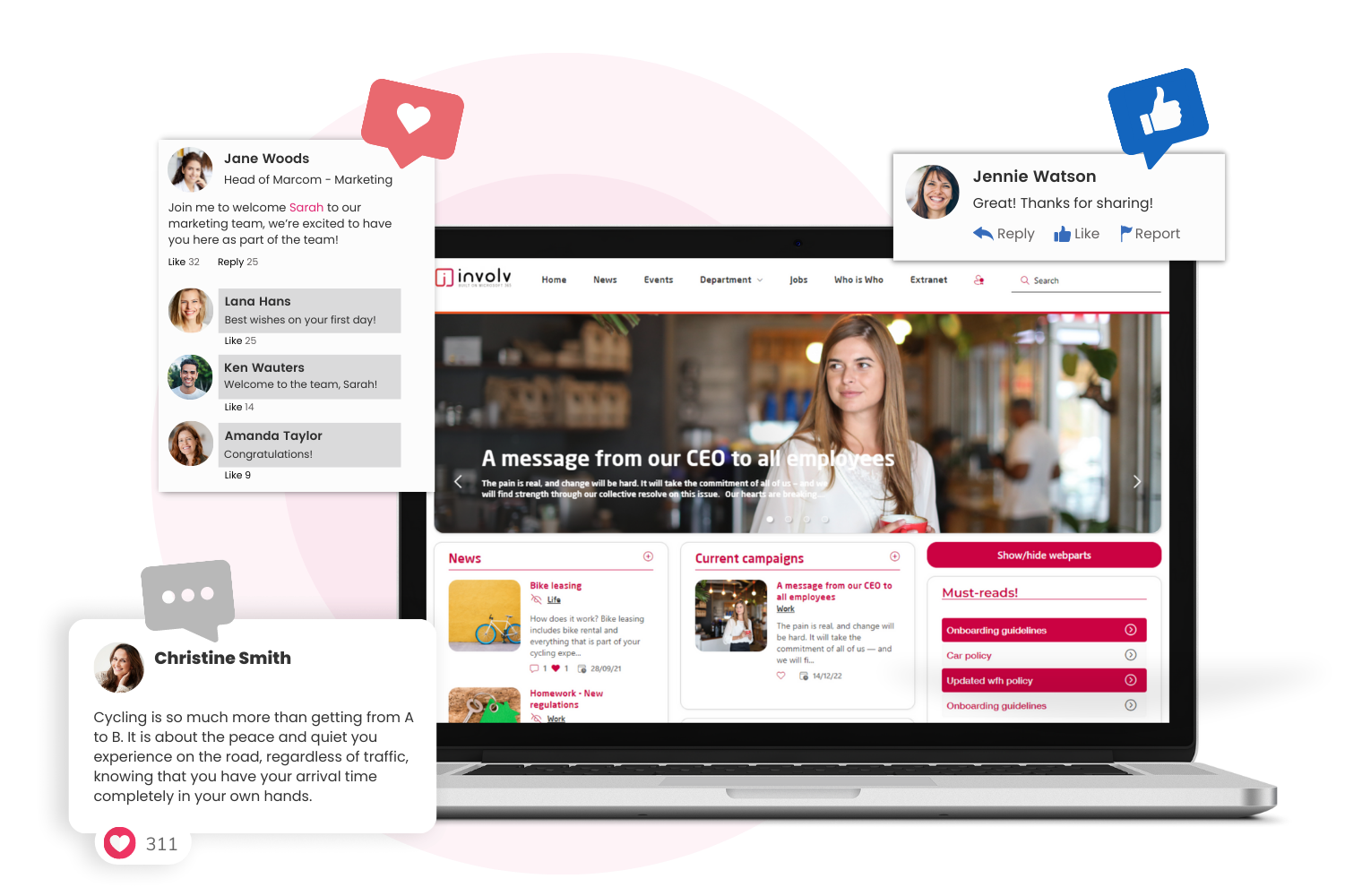Construction companies come with their own unique set of challenges for internal comms. Typically, employees are spread over multiple locations and environments, with large numbers situated on site, rather than at a desk.
The industry is renowned for its transient work force. Plus, with mergers, acquisitions, and sales happening all the time, it’s a minefield to get information to the right people at the right time. Yet, it’s not impossible to do.
We work with numerous construction businesses on tackling these very challenges and below we’ve shared our insider knowledge on how you can use your intranet to improve the internal comms in your construction company.
Create one intranet to unite all subsidiaries
A common challenge for construction companies is the fluidity of business. Large construction companies are frequently buying or absorbing smaller entities.
So, rather than having an intranet for each operating company, it’s best to introduce a global intranet, housed on a single platform, where colleagues from all parts of the business can communicate and share knowledge.
One of the challenges to overcome in taking this approach is with permissions. Best practice is to give every employee guest access to a central tenant and let each sub company use their own SharePoint sites for policies and document storage.
Set clear governance rules for content
Large construction companies typically have offices and operations spread over multiple locations, even countries. The challenge for internal comms is often to decide which language the content should be published in and how to prioritise what content’s displayed, and where.
Best practice is to agree a headquarters language for group-wide information, introducing a multilingual feature so colleagues can translate this content into their language of choice. Other content, such as country-wide or subsidiary company information, should be published in the native mother-tongue.
Content should also be presented in layer format, with group-wide/country/subsidiary information presented in a clear and understandable way. For example, use the big banner for the most important corporate news.
Connect each subsidiary’s ‘who’s who’ into a central people directory
One of the most useful features of an intranet is a people finder, which makes searching and finding colleagues so easy to do. Yet, the challenge for IT is joining up multiple subsidiaries with the mothership company’s people directory.
Although this is not a straightforward process, with a little tech know-how and some customisation, it is possible. Once done, it means every employee, no matter which company they’re working in, can access user profile information for the entire group.
Quick links for easy access to important information
Like with any business, employees in construction need to be able to quickly access content such as holiday application forms, health and safety guidelines, as well as essential information like where and how to order lunch!
In the not-too-distant past, ordering lunch would be done by fax or email. These days you can use your intranet’s Quick Links feature to connect it to a sandwich order app!
Your Quick Links can also include a noticeboard feature for announcements. This is a great way to allow colleagues from across multiple sites to share less official news such as births, birthdays and even retirement dos.
Provide a mobile app for all employees
If every subsidiary company has a Microsoft 365 license it’s possible to give everyone permission to access your intranet via a mobile app. This means site workers can access content on the go and even upload pictures and their own news articles right from the construction site.
Yet, this is only half the picture. In reality, many construction companies hire transient workers on a project-by-project basis. Due to the nature of their work, these colleagues won’t automatically be allocated a M365 license, which means they can’t automatically access content on the intranet.
A simple way to get around this is to give these contractors ‘guest’ access. Which means they can view content, but not contribute to or comment on it.

Calendar and scheduling
The construction world is particularly fraught with multiple deadlines and project management variables. You can use your intranet to host a shared calendar where meetings, deadlines, project schedules, and company events can be tracked. This way everyone can stay on top of their responsibilities and reduce scheduling and timeline conflicts.
Improving internal communication in construction: 5 top tips
Internal communication is crucial in any organisation, but it’s particularly critical in the construction industry, where poor communication can lead to misunderstandings, mistakes, delays, and safety issues.
So, we’ve curated some of the top internal comms tips shared by our customers:
1. Be clear and consistent with messaging
Ensure that all communication is clear, concise, and consistent. This avoids confusion and ensures everyone is on the same page. Use simple language and avoid industry jargon where possible. If you must use technical terms, make sure they are clearly defined and understood.
2. Provide regular updates
Provide regular updates on projects, deadlines, changes, and company news. This helps keep everyone informed and reduces the chance of misunderstandings or misinformation spreading.
3. Use a variety of communication channels
Different people prefer different methods of communication. Use a mix of email, face-to-face meetings, phone calls, video conferences, and your intranet to ensure everyone gets the information they need in a way that works for them.
4. Prioritise safety communication
Safety is paramount in the construction industry. Regularly communicate safety protocols and procedures, and ensure all employees are trained and updated on these matters.
5. Be transparent
Transparency builds trust. Be open about the company’s goals, challenges, and successes. This helps employees feel more invested in the company and fosters a culture of honesty and openness.
these matters.
Read our case study:
Find out how building material distributor Lecot uses their intranet to gather all information in one central location, and improve communication and interaction between employees.
The newly implemented intranet is fully tailored to the needs of the organisation. It is user-friendly and provides employees with a central location where they can find important information and communicate with each other. Additionally, it is fully mobile-friendly so that employees can access the information they need anytime and anywhere. The intranet has resulted in increased efficiency and one central location for all important communications.
Want to know how to use your intranet to improve your internal comms?
Book a demo with one of our friendly experts today for tips and advice.



